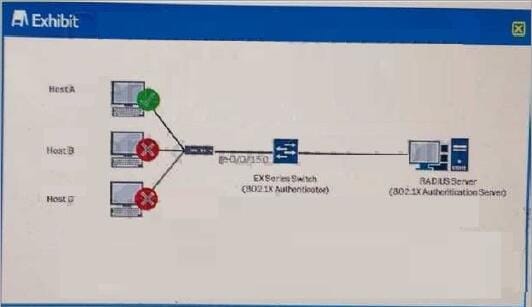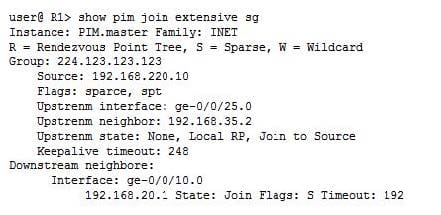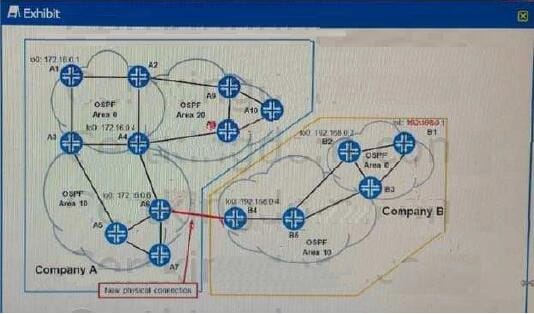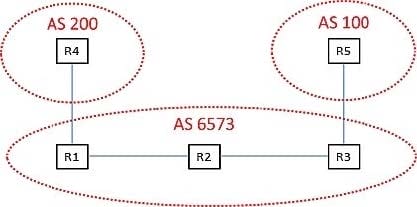Exam Details
Exam Code
:JN0-643Exam Name
:Enterprise Routing and Switching, Professional (JNCIP-ENT)Certification
:Juniper CertificationsVendor
:JuniperTotal Questions
:287 Q&AsLast Updated
:Jun 27, 2025
Juniper Juniper Certifications JN0-643 Questions & Answers
-
Question 61:
Referring to the exhibit, all host A has authenticated using 802.1X B. Which supplicant mode IS USED on the switch?

A. MAC RADIUS
B. Multiple
C. Single
D. Single-secure
-
Question 62:
Which three statements are correct about the PIMoutput shown in the exhibit (Choose three)?

A. R1 has the shortest path tree connection to the multicast source
B. The joint request path me from the client at 192 168 35 2
C. The RP is upstream from R1
D. RP is the RP
E. The multicast stream is flowing out of R1 THROUGH interface ge 0/0/10 0
-
Question 63:
Company A, recently acquired company B. Both network are running multi-area OSPF. You added a new physical question between the locations. You are able to reach both Area 0 networks from Area 10, but you are having connectivity
problems between router A1 and router B1.
Referring to the exhibit, what must you use to facilitate the communication?

A. A multi area link
B. A multi area adjacency
C. A virtual link
D. A virtual private network
-
Question 64:
You are asked to reduce broadcast traffic within the switching domain. You want VLAN broadcast traffic to only go to switches that have VLAN members connected to the network. How would you accomplish this task?
A. storm control on all of the switches in the network
B. configure multiple VLAN registration protocol [MVRP] on all trunk ports in the network
C. use the set vlans
vlan prune command for all configured VLANs D. use the set protocols igmp-snooping vlan all immediate-leave command
-
Question 65:
Which two statements about OSPF external metrics are correct? (Choose two)
A. Type 2 external metrics take the precedence when both metrics are present for a particular destination
B. Type 2 external metrics use only the external cost to the destination and ignore the cost to reach the ASBR
C. When both type 1 and type 2 external paths are available, the paths with the smallest advertise metrics are preferred
D. Type 1 external metrics equal the external cost to the external cost to the destination plus the internal cost to reach the ASBR
-
Question 66:
Which two statements is true regarding the MED attribute? (Choose two)
A. it is not passed across multiple autonomous systems
B. the highest value is preferred
C. it is passed across multiple autonomous system
D. the lowest value is preferred
-
Question 67:
-- Exhibit -
user@router> show configuration routing-options
rib-groups {
foo {
import-rib [ inet.8 inet.2 inet.0 ];
}
}
user@router> show configuration protocols pim
rib-group inet foo;
interface all;
-- Exhibit -
Click the Exhibit button.
Based on the configuration in the exhibit, which routing table is used for IPv4 multicast RPF checks?
A. inet.0
B. inet.2
C. foo.inet.0
D. inet.8
-
Question 68:
-- Exhibit

-- Exhibit -
Click the Exhibit button.
Based on the exhibit, why is R2 marking the routes coming from AS 200 as hidden?
A. R3 has an import policy filtering all routes.
B. R4 is not configured with a next-hop self policy.
C. R2 does not have a route to the peer ID of R4.
D. AS 200 is configured with the advertise-inactive option.
-
Question 69:
-- Exhibit -
{master:0}[edit]
user@router# show class-of-service
classifiers {
inet-precedence normal-traffic {
forwarding-class best-effort {
loss-priority low code-points [ my1 my2 ];
}
}
}
code-point-aliases {
inet-precedence {
my1 000;
my2 001;
}
}
scheduler-maps {
one {
forwarding-class expedited-forwarding scheduler special; forwarding-class best-effort scheduler normal; }
}
schedulers {
special {
transmit-rate percent 30;
priority strict-high;
}
normal {
transmit-rate percent 70;
priority low;
}
}
-- Exhibit -
Click the Exhibit button.
The configuration in the exhibit shows incoming traffic with specific IP precedence bits that should be mapped to a forwarding class named best-effort.
What must you add to complete this configuration?
A. defined behaviors to the interfaces stanza in the class-of-service section
B. rewrite-rules for the best-effort forwarding class
C. a WRED drop-profile for the best-effort scheduler
D. a firewall filter that matches and discards the original code point values
-
Question 70:
-- Exhibit -
user@router> show bgp summary Groups: 1 Peers: 3 Down peers: 0 Table Tot Paths Act Paths Suppressed History Damp State Pending inet.0 0 0 0 0 0 0 inet6.0 1 0 0 0 0 0 Peer AS InPkt OutPkt OutQ Flaps Last Up/Dwn State| #Active/Received/Accepted/Damped... 2001:ffff::3:3 65550 43 43 0 0 18:20 Establ inet6.0: 0/1/1/0 2001:ffff::3:4 65550 42 43 0 0 18:16 Establ inet6.0: 0/0/0/0 2001:ffff::9:7 65550 42 43 0 0 18:00 Establ inet6.0: 0/0/0/0
user@router> show route receive-protocol bgp 2001:ffff::3:3
inet.0: 32 destinations, 33 routes (32 active, 0 holddown, 0 hidden)
__juniper_private1__.inet.0: 4 destinations, 4 routes (2 active, 0 holddown, 2 hidden)
iso.0: 1 destinations, 1 routes (1 active, 0 holddown, 0 hidden)
mpls.0: 3 destinations, 3 routes (3 active, 0 holddown, 0 hidden)
inet6.0: 10 destinations, 14 routes (10 active, 0 holddown, 0 hidden) Prefix Nexthop MED Lclpref AS path 2001:1:2::/64 2001:ffff::3:3 100 I user@router> show route 2001:1:2::
inet6.0: 10 destinations, 14 routes (10 active, 0 holddown, 0 hidden) + = Active Route, - = Last Active, * = Both
2001:1:2::/64 *[OSPF3/10] 01:54:11, metric 201
> to fe80::217:cb03:2448:bd00 via fe-0/0/1.804
[BGP/170] 00:18:43, localpref 100, from 2001:ffff::3:3 AS path: I > to fe80::217:cb03:2448:bd00 via fe-0/0/1.804
user@router> show route advertising-protocol bgp 2001:ffff::9:7
user@router> show configuration protocols bgp
group ibgpv6 {
type internal;
local-address 2001:ffff::3:5;
cluster 10.0.3.4;
neighbor 2001:ffff::3:3;
neighbor 2001:ffff::3:4;
neighbor 2001:ffff::9:7;
}
user@router>
-- Exhibit -
Click the Exhibit button.
You are using an IBGP route reflector within your network. Your route reflector has received the 2001:1:2::/64 prefix, but it is not advertising the prefix to its cluster members. After examining the route reflector, you notice the output shown in
the exhibit.
Which configuration statement causes the route reflector to transmit the route to its IBGP peers?
A. set protocols bgp group ibgpv6 advertise-inactive
B. set protocols bgp group ibgpv6 accept-remote-nexthop
C. set protocols bgp group ibgpv6 multipath
D. set protocols bgp group ibgpv6 include-mp-next-hop
Related Exams:
JN0-102
Internet Associate, Junos(JNCIA-Junos)JN0-104
Junos, Associate (JNCIA-Junos)JN0-105
Junos, Associate (JNCIA-Junos)JN0-1101
Juniper Networks Certified Design Associate (JNCDA)JN0-1103
Design, Associate (JNCIA-Design)JN0-130
Juniper networks Certified internet specialist.e(jncis-e)JN0-1301
Data Center Design, Specialist (JNCDS-DC)JN0-1302
Data Center Design Specialist (JNCDS-DC)JN0-1331
Security Design, Specialist (JNCDS-SEC)JN0-1332
Security Design, Specialist (JNCDS-SEC)
Tips on How to Prepare for the Exams
Nowadays, the certification exams become more and more important and required by more and more enterprises when applying for a job. But how to prepare for the exam effectively? How to prepare for the exam in a short time with less efforts? How to get a ideal result and how to find the most reliable resources? Here on Vcedump.com, you will find all the answers. Vcedump.com provide not only Juniper exam questions, answers and explanations but also complete assistance on your exam preparation and certification application. If you are confused on your JN0-643 exam preparations and Juniper certification application, do not hesitate to visit our Vcedump.com to find your solutions here.